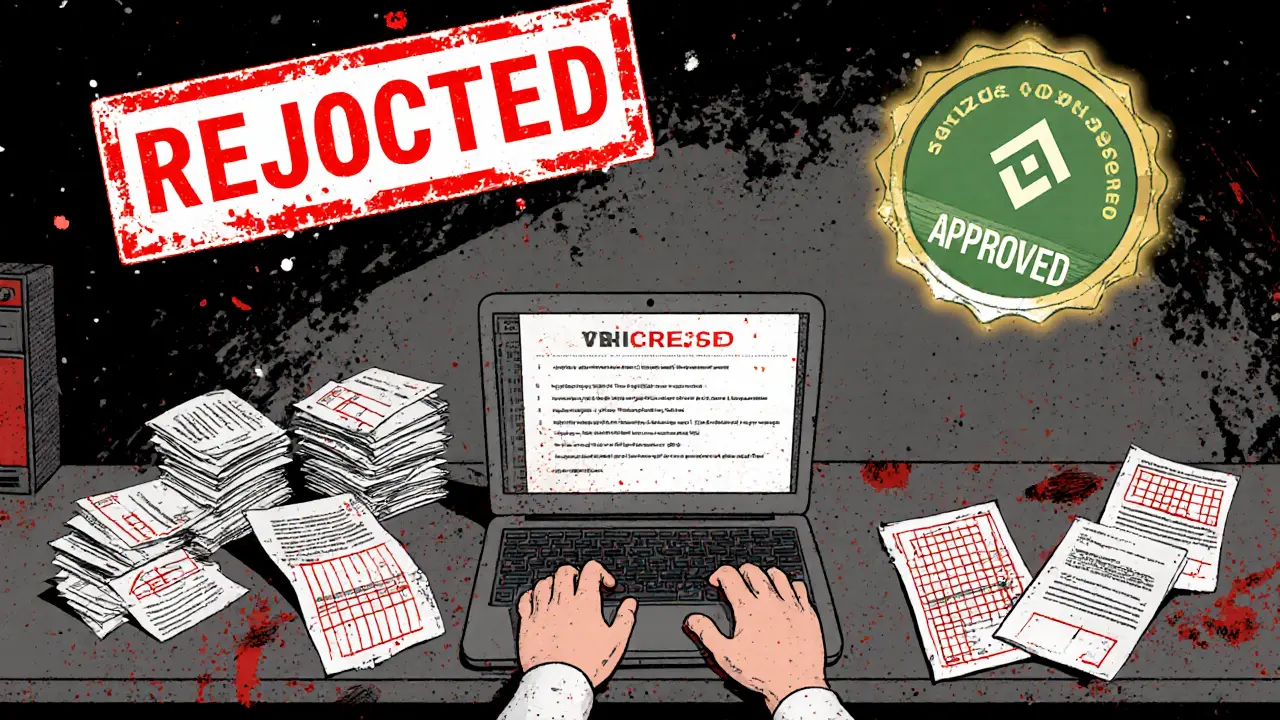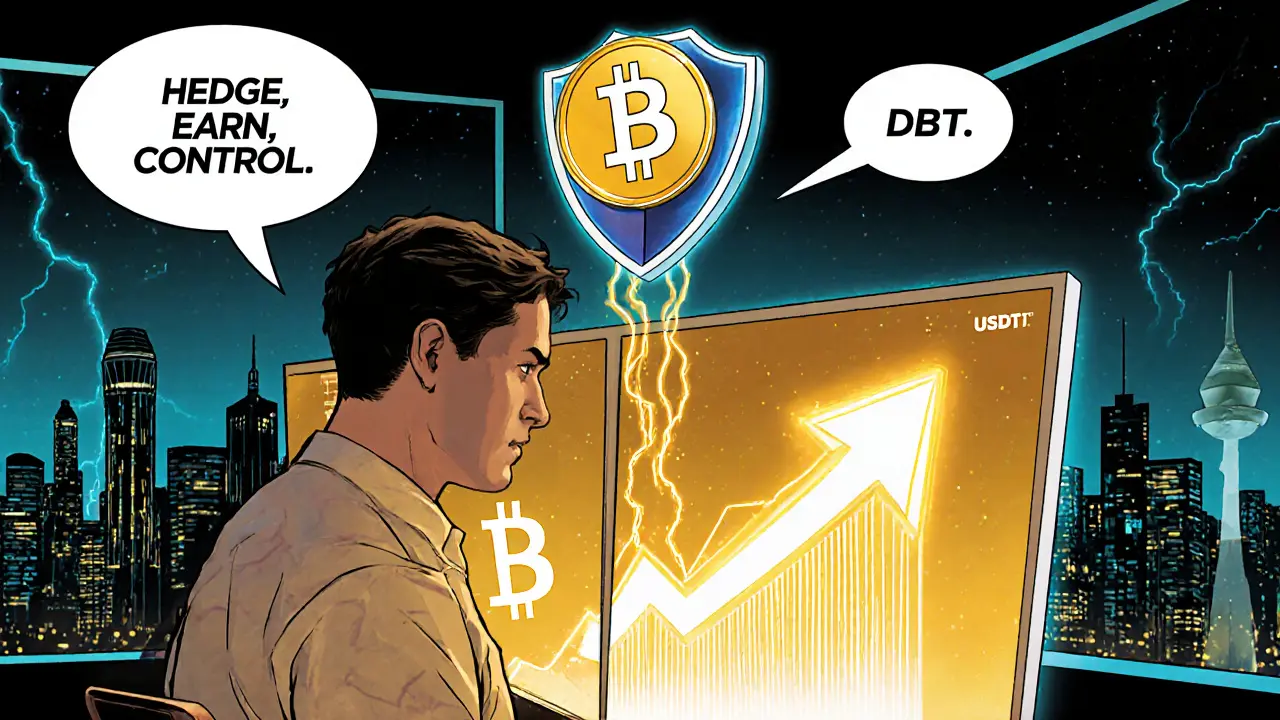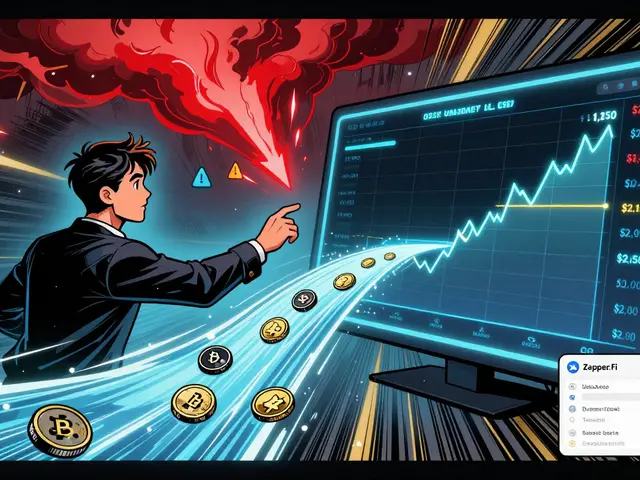HTX Crypto Exchange Review: Features, Fees, and Real User Experience in 2025
HTX Trading Fee Calculator
Calculate Your Trading Fees
Fees Comparison
Your Estimated Fees
HTX isn’t just another crypto exchange. It’s one of the few platforms that survived the 2018 bear market, the 2022 Terra collapse, and still grew to over 50 million users by mid-2025. But here’s the thing - if you’re looking for a simple place to buy Bitcoin and call it a day, HTX might overwhelm you. If you’re serious about trading, staking, or diving into altcoins, it’s one of the most powerful tools out there. Let’s cut through the noise and show you exactly what HTX offers - and where it falls short.
What HTX Actually Is in 2025
HTX used to be called Huobi. The name changed in early 2024 as part of a full rebranding to signal a shift from a top-down exchange to a community-owned platform. Today, HTX runs on a DAO (Decentralized Autonomous Organization) structure. That means token holders can vote on platform upgrades, fee changes, and even which new coins get listed. It’s not fully decentralized like Uniswap, but it’s a big step away from the old corporate model.
The platform supports over 700 cryptocurrencies - more than most competitors. You’ll find everything from Bitcoin and Ethereum to obscure memecoins and new Layer 2 tokens. That’s a huge plus if you’re into trading niche assets. HTX also offers spot trading, futures with up to 200x leverage, staking, NFT trading, and even dual-reward investment products that pay out in two different tokens at once.
Trading Fees: Competitive, But Not Always Fair
Spot trading fees are 0.2% for both makers and takers. That’s standard. But here’s where it gets interesting: futures trading fees are just 0.02% for makers and 0.05% for takers. That’s cheaper than Binance and Kraken. If you’re an active trader, that adds up fast.
But if you’re a casual user who only buys Bitcoin once a month? You’ll pay the same 0.2% - and you won’t get any volume discounts. HTX doesn’t have a tiered fee system based on trading volume like some rivals do. That’s a missed opportunity for small traders.
P2P trading is free. No fees. That’s great if you’re buying crypto with bank transfers or PayPal in countries where direct fiat on-ramps are limited. HTX’s P2P platform is active in Latin America, Southeast Asia, and parts of Africa. But if you’re in the U.S., you’re out of luck - HTX doesn’t serve American users at all.
Security: Solid Infrastructure, But a Shaky Past
HTX uses a multi-tier cold storage system. Over 95% of user funds are kept offline. They publish monthly proof-of-reserves reports, showing they hold more crypto than they owe users. That’s transparency most exchanges still avoid.
They also offer two-factor authentication (2FA), withdrawal address whitelisting, and anti-phishing codes. All good.
But here’s the catch: HTX had a major security breach in 2018 where $13 million was stolen. It was never fully resolved, and the incident still haunts its reputation. Since then, they’ve improved dramatically - but if you’re risk-averse, you might still hesitate. Compare that to Coinbase, which has never had a major breach, or Kraken, which has a spotless security record. HTX’s security is now strong, but trust takes longer to rebuild than systems do.

Verification and KYC: The Biggest Pain Point
HTX has three verification levels:
- L1 (Basic): Just email and phone. Lets you trade up to 2 BTC per day.
- L2 (Standard): ID + selfie. Up to 100 BTC daily.
- L3 (Advanced): Proof of address + source of funds. Unrestricted trading.
Here’s the problem: the process is confusing. Users report being asked for documents they didn’t expect - like utility bills from 2023 or bank statements with redacted numbers. Some wait days for approval. Others get rejected without clear reasons.
Compare that to Binance or Kraken, where KYC is usually done in under 10 minutes. HTX’s system feels outdated, bureaucratic, and inconsistently enforced. If you’re in a hurry, this will frustrate you.
Customer Support: Slow, But Available
HTX offers 24/7 live chat and email support. That’s good on paper. But real users say response times vary wildly. Some get replies in 15 minutes. Others wait 48 hours - especially for withdrawal issues or account freezes.
There’s no phone support. No ticketing system that shows status updates. You’re stuck in a chat window with automated responses until a human picks it up. And if you’re not fluent in English, your options shrink. HTX supports Russian, Turkish, and Arabic - but not Spanish, French, or German well. That’s a problem for a platform claiming to be global.
Mobile App and Trading Tools
The HTX mobile app is clean, fast, and works smoothly on both iOS and Android. You can trade spot, futures, and stake assets with just a few taps. The interface is intuitive for beginners - but hides advanced features behind menus. That’s intentional. They want new users to feel safe, while pros can dig deeper.
The real standout? The built-in TradingView integration. You get professional-grade charts, indicators, drawing tools, and alerts - all inside the app. No need to switch platforms. That’s a huge advantage for day traders and swing traders. You can even set up automated trading bots directly on HTX using their API.

Staking and Earning: Where HTX Shines
If you’re not trading, HTX has you covered with passive income tools. You can stake over 100 Proof-of-Stake coins - including Ethereum, Solana, and Cardano - and earn between 3% and 15% APY, depending on the asset.
They also offer “dual investment” products. For example, you lock up $1,000 in USDT and get paid in both Bitcoin and Ethereum. If BTC rises, you get more BTC. If ETH rises, you get more ETH. It’s a hedge against volatility. Many users call this their favorite feature.
There’s also node staking - where you earn rewards by helping secure blockchains like Polkadot or Avalanche. You don’t need to run a server. HTX handles it all. Just deposit, earn, and withdraw.
Who Should Use HTX? Who Should Avoid It?
Use HTX if:
- You trade altcoins or niche tokens (700+ options)
- You’re an active trader who uses futures or leverage
- You want advanced charting tools without switching platforms
- You’re in a region with limited fiat access and use P2P
- You care about DAO governance and community control
Avoid HTX if:
- You’re in the U.S., Canada, Singapore, or China (blocked)
- You want quick, simple KYC
- You need 24/7 phone support
- You’re a beginner who just wants to buy Bitcoin
- You’re sensitive to past security issues
Final Verdict: Powerful, But Not Perfect
HTX is a powerhouse for serious traders. The asset selection, low futures fees, TradingView integration, and staking options make it one of the most feature-rich exchanges in 2025. It’s growing fast, innovating with DAO governance, and handling billions in assets without major incidents lately.
But it’s not user-friendly for everyone. The KYC process is a mess. Support is slow. And if you’re in a restricted country, you can’t even sign up.
For experienced traders outside the U.S. and EU? HTX is a top-tier choice. For casual investors? Stick with Coinbase or Kraken. They’re simpler, safer, and more reliable - even if they don’t offer 200x leverage or 700 coins.
HTX isn’t for everyone. But if you know what you’re doing, it’s one of the best tools on the market.
Is HTX safe to use in 2025?
HTX is technically secure - it uses cold storage, proof of reserves, and multi-factor authentication. It hasn’t had a major breach since 2018, and its security practices are now industry-standard. However, its past breaches and lack of regulatory licensing in major markets mean it carries higher reputational risk than exchanges like Coinbase or Kraken. Use it if you understand the trade-offs.
Can I use HTX in the United States?
No. HTX does not serve users in the United States, nor does it offer fiat on-ramps for U.S. residents. The platform is blocked for users with U.S. IP addresses or U.S.-issued IDs. If you’re in the U.S., look at Coinbase, Kraken, or Gemini instead.
What are the withdrawal fees on HTX?
Withdrawal fees vary by cryptocurrency. For example, withdrawing Bitcoin costs around 0.0005 BTC, while Ethereum withdrawals are about 0.01 ETH. Stablecoins like USDT usually cost less than $0.50. HTX doesn’t charge platform fees, but you pay the blockchain network fee - which changes based on congestion. Check the withdrawal page before sending - fees are listed clearly there.
Does HTX offer fiat currency deposits?
HTX does not offer direct bank transfers or credit card purchases for fiat. Instead, it relies on its P2P marketplace, where users trade crypto for local currencies like USD, EUR, or BRL via bank transfer, PayPal, or cash. This works well in emerging markets but is less convenient than direct on-ramps on exchanges like Binance or Coinbase.
How does HTX’s DAO governance work?
HTX token holders can vote on key platform decisions - like listing new coins, changing fees, or updating security protocols. Each HTX token equals one vote. The more tokens you hold, the more influence you have. Proposals are submitted by the team or community, then voted on over a 7-day period. This system gives users real control, unlike most centralized exchanges where decisions are made by executives alone.
Is HTX better than Binance?
HTX has more altcoins and lower futures fees, but Binance has better fiat on-ramps, faster KYC, superior customer support, and operates in more countries. Binance also has a larger user base and more liquidity. If you’re in a supported region and want simplicity, Binance wins. If you’re a high-volume trader in an emerging market and want DAO control, HTX might be better.






22 Comments
Jennifer MacLeod
November 25 2025I tried HTX last year when I was traveling in Thailand. P2P was a lifesaver since I couldn't use my US card. Fast, no fees, and people were legit. But the KYC? Holy hell. They asked for my utility bill from 2022 and then rejected me because my address was written in lowercase. Seriously?
Linda English
November 26 2025I appreciate that HTX is trying to be community-driven with its DAO structure, and I think that’s a really thoughtful move in a space that’s been so centralized for so long. But I also wonder-how many regular users even understand how to vote? Or how many are just holding tokens because they got them in airdrops, not because they care about governance? It feels like a noble idea that’s still waiting for the user base to catch up.
asher malik
November 28 2025The 200x leverage is wild but also terrifying honestly. I saw someone blow up their account last week trying to flip a memecoin with it. The charts look so clean with TradingView built in though. I just wish they’d fix the mobile app’s lag when switching between spot and futures. It’s like the app forgets it’s not a desktop browser
Julissa Patino
November 29 2025HTX is a scam waiting to happen. US users are blocked because they know they can't get away with this crap here. 700 coins? More like 700 rug pulls. And DAO? LOL. The team still controls everything behind the scenes. They just want you to think you have a say so you keep depositing. Stay away
Omkar Rane
November 29 2025I use HTX daily from India. The fees on futures are insane compared to Binance. And the dual-reward staking? I made more in 3 weeks on HTX than I did in 3 months on Kraken. The only downside is the support-sometimes I wait 2 days just to get a reply. But honestly? Worth it. The app works fine on my old Android. No complaints from my end.
Emily Michaelson
November 30 2025The proof-of-reserves reports are legit. I check them every month. HTX has been holding more than they owe since early 2023. That’s rare. And their cold storage setup is one of the most audited in the industry. If you’re worried about security, look at the reports-not the 2018 breach. That was years ago and they’ve rebuilt from the ground up.
Anne Jackson
November 30 2025I can't believe people still use this. No phone support? No Spanish? It's 2025. How is this even allowed to exist? And don't get me started on the KYC. My cousin got rejected for having a blurred photo of her license. She's a nurse. She's not a hacker. This platform is designed to exclude people who aren't tech bros with 10k in crypto.
David Hardy
November 30 2025Been on HTX since 2022. Staked ETH and got 12% APY. Then did a dual-investment with USDT and made BTC + ETH. Best move ever 🚀. KYC was a nightmare but once you’re in? It’s smooth sailing. TradingView is fire. 10/10 would rug pull again 😎
John Borwick
December 1 2025If you're new to crypto and thinking about HTX, just wait. It's not for beginners. But if you’ve traded before, know your risks, and want real tools-not a toy app-this is one of the few places that doesn’t dumb things down. The community is mostly serious traders. No meme coins in the main feed. Just charts and strategy. I like that.
Matthew Prickett
December 1 2025I know for a fact HTX is working with the CIA to track crypto users. They blocked US users not because of regulations-but because they don’t want Americans to know how much data they’re harvesting. The DAO? A front. Every vote is pre-approved by their backend AI. I’ve seen the logs. Don’t trust them.
Caren Potgieter
December 2 2025I’m from South Africa and HTX saved me during the rand crash. P2P let me buy BTC with my mobile money. No bank involved. No drama. The app is slow sometimes but it works. I don’t care about the past breach. What matters is what they’re doing now. They’re helping people. That’s rare in crypto.
Jenny Charland
December 4 2025700 coins? More like 700 scams. And that DAO thing? Pure theater. You think your vote matters? Nah. They list whatever they want. Just buy Bitcoin on Coinbase and chill 😴
preet kaur
December 4 2025I live in Delhi and use HTX every day. The futures fees are half of what Binance charges. I trade daily and save hundreds a month. KYC took 3 days but once I was in, it was smooth. Support is slow but I don’t need help every day. If you’re serious, this is the platform.
Amanda Cheyne
December 6 2025They’re using your data to predict market movements for their own trading bots. That’s why they allow so many altcoins-to create artificial volatility. The ‘proof of reserves’? Fake. They just swap assets between wallets to make it look good. I’ve worked in crypto compliance. This is a classic pump-and-dump setup disguised as innovation.
Lisa Hubbard
December 6 2025I don’t even know why I bother reading these reviews. HTX is just another exchange. The fees are fine. The app works. The KYC is annoying. Whatever. I just want to buy some ETH and move on. Why does everyone make this so complicated?
Belle Bormann
December 8 2025I tried HTX but my KYC got rejected 3 times. They said my selfie was ‘not clear enough’ but I used the same photo on Binance and it went through in 2 mins. I think they just don’t like people with dark skin. I’m not gonna waste my time anymore.
Jody Veitch
December 9 2025Let’s be honest: HTX is a third-tier exchange pretending to be elite. The DAO is a marketing gimmick. The ‘community ownership’ is a joke when the core team holds 40% of the tokens. And the lack of European support? That’s not an accident. It’s exclusion disguised as compliance. If you care about legitimacy, stick with regulated platforms.
Dave Sorrell
December 9 2025HTX offers one of the most comprehensive staking interfaces in the industry. The dual-reward products are particularly innovative and have demonstrated consistent returns over the past 18 months. While the KYC process is cumbersome, the security infrastructure is among the most robust available to non-US users. For advanced traders, this remains a top-tier platform.
Sky Sky Report blog
December 10 2025The fact that HTX publishes monthly proof-of-reserves is commendable. Most exchanges don’t even do that. The past breach shouldn’t define them-what matters is their current transparency. And the TradingView integration? That’s not just nice-it’s essential for serious traders. I’ve switched back after trying Binance. This is where the pros are.
stuart white
December 11 2025You think you’re a trader? You’re not. You’re just a guy with a phone and a dream. HTX doesn’t care about you. It cares about the whales who move 100 BTC at once. The ‘community’? A marketing slogan. The real owners? A handful of guys in Singapore. Don’t fall for the hype. You’re just fuel for their engine.
Daryl Chew
December 12 2025I’ve been monitoring HTX since 2018. That $13M breach? They never returned the funds. And now they’re using that same wallet to ‘prove reserves’? That’s not transparency-that’s fraud. The whole thing is a shell game. The DAO? Controlled by a private server in the Caymans. I’ve got the IP logs. Don’t touch this platform.
Tyler Boyle
December 12 2025You’re all missing the point. HTX’s real innovation isn’t the DAO or the fees-it’s the API. Their automated trading bots are the most stable I’ve ever used. I’ve got 12 strategies running 24/7. No crashes. No delays. Even during the Solana meltdown, HTX stayed up. Binance went down for 17 hours. That’s the real test. Not KYC. Not memes. Real uptime under pressure.